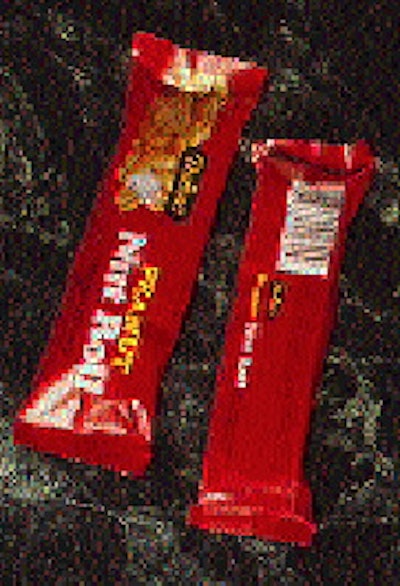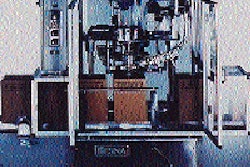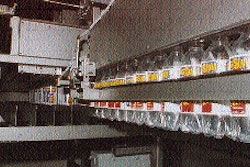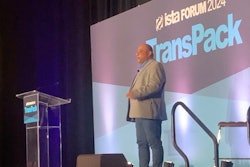When PW visited American Packaging Corp.'s Columbus, WI, Rotogravure Printing & Laminating Division late last winter, the converter had recently completed a $17 million expansion that not only doubled its size, but added machinery to keep pace with increasing demand and tap into new markets, particularly cold seal applications. "This was a huge project," relates Michael DuRoche, Philadelphia-based AP's vice president and general manager. "We approached the project in 1992 with the goal of renovating our plant and adding new capabilities. We had outgrown our facility in terms of size and capacity." The expanded plant exceeds 200ꯠ sq ft, about double its previous size. Equipment-wise, the Columbus facility added: (1) a Cerutti 950 11-station gravure press, from North American Cerutti (Pittsburgh, PA); (2) a computerized 35-level high-density storage and handling system that stores and automatically retrieves nearly 12ꯠ printing cylinders; (3) a slitter from Kampf Machinery (Nashville, TN); and (4), an elaborate incineration system. "Our initial expectations called for a seven-year return on investment," says DuRoche. "This project wasn't funded to generate a quick ROI, but to modernize our Columbus operations. Right now, it's right on target and giving us just what we were looking for." Hot for cold sealing The lucrative confectionery market was a key target for AP's Columbus plant. Trouble was, until the plant upgrade, and the addition of the Cerutti, that target was out of range. "On some of our existing equipment, we could apply cold seal in line, but not with post lamination. The Cerutti expands our capabilities in this area," DuRoche points out. "The advantage is in applications for the candy industry where reverse-printed film is laminated to a barrier layer, with cold seal applied in register, after printing. We could not have done that in the past." One of the first jobs requiring post-printing cold seal application was for St. Paul, MN-based Pearson Candy Co.'s 1.8-oz Peanut Nut Roll wrapper. The five-color wrapper is primarily bright red, highlighted by a close-up view of the cylindrical-shaped peanut bar with its bright white chewy inside. Printing the wrap might not sound terribly challenging, but its final appearance is critical to the nearly 90-year-old candy producer. "The bar is one of our highest-volume sellers," explains Don Svitak, Pearson's director of materials management. "The peanut vignette that appears on the top of the wrapped candy bar is meant to pop out and attract the consumer. It's truly tricky to print the peanuts in just the right color so that they look like fresh peanuts. Printed by different converters, there was some color variation in the peanut. With the Cerutti, the color of the peanuts and white center are consistent, and help attract potential buyers." Besides color consistency, Pearson's was dissatisfied with the seal integrity provided by some of its other converters. "In the past, some of the seals didn't hold tightly, causing occasional opening," Svitak says. "Those bars didn't go out to the market, but we had a problem. Whether the converter, film or sealant was at fault didn't matter to us, as long as we corrected the situation." The sealing solution is attributable to the Cerutti, Mobil Chemical's (Pittsford, NY) film, and an adhesive from Findley Adhesives (Wauwatosa, WI). Custom printing On the new Cerutti, the Pearson candy bar wrap is printed 8-up, at speeds averaging 650'/min. A web-lifting device automatically hoists a 48 1/4"-wide web of Mobil Chemical's 1.7-mil Oppalyte® 250ASW oriented polypropylene film onto the unwind unit at the infeed side of the press. "The film has a very good moisture barrier, and is pleasing esthetically," says DuRoche. "We've found that it's really the film of choice for the candy industry and it's specified by Pearson's for this candy bar wrapper." The web unwinds and travels past the first two stations, one for laminating, the other for printing. Neither is necessary for Pearson's wrap. Red, yellow, brown, background red and white solvent-based inks are applied at stations 3 through 7. After each color, the web ascends through a hot air drying section positioned above the print stations. At the eighth station, a cold-seal release overprint lacquer is applied on top of the inks to provide scuff-resistance. After it dries, Findley Adhesives' cold-seal latex adhesive is pattern-applied in register onto the back of the web. A doctor blade wipes away adhesive from those areas on the web not designed to receive the material. "On the Cerutti, cold adhesive application is simply another function," states Pearson's Don Svitak. "Our prior sealing problems had a lot to do with adhesive that wasn't applied evenly. In some spots we didn't have adhesive. Those problems caused some wrappers to open up. From this machine, the wrappers have had no sealing difficulties." The cold-sealed web then winds through a 32-ft drying oven. "It's specially designed for cold-seal applications," notes DuRoche. "It's about four times longer than the dryers above the printing stations, so there's a longer dwelltime. Also, there is a higher velocity of air blown through this dryer. The adhesive is formulated to match our press speeds and drying capabilities to achieve the proper seal." Finally, the web bypasses a post-laminating station and is rewound. The roll is placed onto the new Kampf unit where it's slit into 5 7/8"-wide rolls. Unitized pallet loads of the slit rolls are shipped to Pearson's for horizontal form/fill/sealing. Bottom-line benefits Pearson's has been pleased by the wrap that AP's Columbus plant has produced. Its repeat orders are proof positive. "We moved from flexographic printing to gravure about five years ago to improve the print quality," says Svitak. "When American Packaging had the new Cerutti running, they provided samples that impressed us. We needed an additional supplier, so we gave them an initial order of about five million wrappers. Conservatively speaking, they'll print in excess of 20 million wrappers for us this year." Prior to adding the Cerutti, the Columbus plant operated three gravure presses. "We needed additional capacity," explains DuRoche. "We reviewed many different machines in the U.S. and in Europe, analyzing their capabilities. The Cerutti best fit our needs, though this machine isn't an off-the-shelf model that you see at a show, take it down and set up at your plant. It's customized throughout, including pre- and post-print laminating stations, drying ovens, printing and cold sealing. It runs much more efficiently than our other gravure presses, and it has exacting controls to hold tight registrations. It produces cold seal jobs with excellent print quality." DuRoche says annual sales from Columbus exceeded $50 million prior to adding the Cerutti. "The press has added nearly $20 million in annual capacity," he says. And while he won't provide specific sales gains to date, he does attribute a 20% sales increase to the press. The same cold sealing capability that benefits Pearson's is now also used for granola bars, tea packages and gum wrappers in Columbus.























